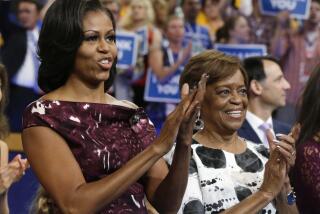A First Lady’s Metamorphosis
- Share via
WASHINGTON — When the first jet dove into the World Trade Center that Tuesday morning, Laura Bush was upstairs in the official residence, preparing to become only the fourth first lady in history to address a committee of Congress.
When the second plane followed 16 minutes later, she was in a motorcade on the way to the Capitol, well aware that the remarks on early education she had practiced the night before would not be delivered that day.
She was soon huddled in a Senate office with her press secretary, cobbling together a message that helped comfort a horrified nation and irrevocably changed the choreographed and scripted course of her tenure.
Just as her husband’s presidency shifted with the terrible events of Sept. 11, so did the public role of Laura Bush, a once-reticent political spouse who was more often seen than heard in the early months of the Bush White House.
“I think the perception with most people was they hadn’t seen her much,” said Myra Gutin, a historian at Rider University in New Jersey. “But you cannot hide out in the White House. You need to go out and go on the record and declare your support and be seen. Tragedy demands a response, and she has responded very nicely.”
As summer ended, Mrs. Bush had been moving steadily toward a higher profile. On Sept. 5, she and her husband hosted their first state dinner, for Mexican President Vicente Fox. On Sept. 8, she launched the first National Book Festival. Her Sept. 11 testimony was to have been before a Senate education subcommittee. Then, disaster catapulted her into the spotlight.
She made the rounds of all the network talk shows the morning after the attacks and has been a steady television presence ever since. She’s done “Oprah,” “60 Minutes” and “Larry King Live,” visited the crash sites in New York and Pennsylvania, visited those wounded at the Pentagon in hospitals, led blood drives, consoled firefighters and helped the nation articulate its sorrow. A celebrity fund-raiser that aired on every network just days after the mayhem ended with the steady voice of Mrs. Bush reminding a nation to hug its children.
In letters distributed to schools throughout the country, she has acknowledged students’ fears and called on them to be good citizens: “Always take care of your family, friends, neighbors and those in need.” She recently spent more than 90 minutes with children who were evacuated from New York’s Public School 41 and hadn’t yet returned, reading them “I Love You, Little One,” by Nancy Tafuri.
“It is really in a political crisis or a national emergency when one sees the true mettle of a first lady,” said Carl Sferrazza Anthony, a Los Angeles-based historian specializing in first ladies. “She had already prepared mentally and emotionally to be playing a large public role. The crisis made it a much larger and sadder role than expected.”
Her presence in the midst of catastrophe is bringing her into sharper focus for a country that had not had the opportunity to know her well. In a poll taken last summer by the Pew Research Center for the People and the Press, 64% had a favorable view of Mrs. Bush, but not a strong impression of her. (When asked which presidential wife most embodied the role of first lady, the most common responses were Nancy Reagan, Barbara Bush and Hillary Rodham Clinton.)
The emerging picture of Laura Bush is different from that of her recent predecessors. She is part of her husband’s presidency, but not a partner in it. A former teacher and librarian, her concern for children seems to transcend motherhood--a passion that is both personal and professional, stemming from the head as much as the heart.
“If you put all the pieces together, you see that her role as the ‘un-Hillary’ has not been to turn back the clock and become Mamie Eisenhower, either. She’s been trying to do this the third way,” said Gil Troy, a presidential historian at McGill University in Montreal.
The attacks forced her onto new ground--to help steady a country that has witnessed the worst single day’s carnage since the Civil War. Even as leaders warn of more terrorism, Mrs. Bush is urging a return to normality. Asked in a recent interview if she had been vaccinated in case of a biochemical assault, she said she had declined. “I just didn’t really feel like it was necessary,” she said, heading to Cincinnati to resume her previously scheduled agenda, a seminar on early cognitive development.
Most first ladies begin with the belief that the job is what they make it--”that’s what they tell each other,” Troy said. But some experts say the experience is more often shaped by history’s unforeseeable events.
Dolly Madison was viewed as little more than the chatelaine of the mansion until the British burned the White House during the War of 1812. Her gestures of strength, including saving Gilbert Stuart’s priceless portrait of George Washington, transformed her from savvy hostess to a national symbol cited for patriotism and bravery.
Eleanor Roosevelt, active in righting social injustices in her husband’s early presidency, assumed a maternal quality when she visited thousands of American troops, an undertaking that changed the country’s ambivalent attitude toward her. And Betty Ford’s breast cancer enabled her to bring a deadly disease out of the closet and save lives, a role she could not have envisioned when she moved into the White House. (Her public disclosure of alcoholism and the founding of the Betty Ford Center in Rancho Mirage took place after her husband’s presidency.)
“The job starts off with a whole host of boundaries and expectations imposed by the American people and by tradition, but in the warp and woof of Washington, an internal momentum is created,” Troy said. “That’s what we are seeing now. It feels like the ground is shifting.”
The challenge of a modern first lady is to strike a balance between the traditions the job demands and the multidimensional role of a modern wife. The nation wants her to be slightly more retro than many American women, Anthony said, adding, “when there is a state dinner, you don’t want her in a shocking-pink pantsuit.”
But she is still expected to rise to modern challenges and tragedies. The job description is the same--help with the national healing, convey a sense of reassurance--but the playbook has to be reinvented because the event is unfathomable, historians agreed.
“To an extent you are seeing both a president and a first lady come into their own,” Troy said.
One of a first lady’s most important functions is more private than public: centering a president who is also a human being with all the attending insecurities. Nancy Reagan hawkishly monitored her husband’s diet, sleep and schedule during the Iran-Contra scandal and through his health problems. President Kennedy cried in front his wife during the Bay of Pigs and confided to her his most personal fears during the Cuban missile crisis, said Anthony, author of “The Kennedy White House--Family, Stories and Pictures, 1961-1963.”
Laura Bush has kept her ministrations private as she and her husband attempt to resume as normal a life as possible, calling on the nation to do the same.
“This is a very different situation. It’s deeper than a pep talk or a morale boost, it’s a much deeper kind of exchange that might occur between the two of them,” said her press secretary, Noelia Rodriguez.
In public, though, it is the country the first lady is expected to comfort. “Nobody ever says it, but we react to a first lady the way we react to our own mothers,” Anthony said. “We criticize her, we want to love her, we are embarrassed by her and we’re hypercritical. But when the world blows up, she’s the one we want.”
The first lady’s actions in these weeks will largely determine how history judges her. She is bonding with the nation, helping it heal in a way she had no time to plan, in a time she could not have forecast. Once Americans get used to seeing her, it will be hard for her to assume a less public role.
“It will be much harder to take a step back to having a lower profile,” Gutin said. “This is her emergence.”
More to Read
Get the L.A. Times Politics newsletter
Deeply reported insights into legislation, politics and policy from Sacramento, Washington and beyond. In your inbox twice per week.
You may occasionally receive promotional content from the Los Angeles Times.








